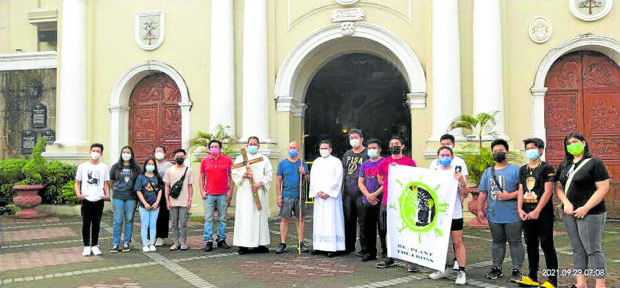
CROSSES AND TREES: The pilgrimage welcoming the next 500 years of Christianity in the Philippines started last month through church visits and by encouraging young people to plant 500 crosses and native trees. (Photo by SANSU FUSTER / Contributor)
GUAGUA, PAMPANGA—Rhiane Baccay, 14, knows a bit of her history as a Filipino Catholic.
Everything about her growing up in that religion in the former town of Betis here—also called “pueblo levitico,” or a place of many priests—began 500 years ago.
This Grade 9 pupil knows about the first Mass celebrated by Fr. Pedro de Valderrama and the planting of the first cross on Limasawa Island in Southern Leyte as well as the baptism of natives in Cebu province during the expedition of Portuguese explorer Ferdinand Magellan in 1521.
These events, she was told, planted the seeds of Christianity while Spain ruled the country as a colony.
The Holy Angel University Center for Kapampangan Studies has enriched the appreciation of the quincentenary by sharing the research of writer and historian Luciano P.R. Santiago.
Kapampangans, Santiago found out, became pioneers of the Catholic Church in the Philippines after the second set of explorers ventured in Luzon in 1571 and the Augustinians made Pampanga its first territory in 1572.
Miguel Jeronimo de Morales and Francisco Baluyot became the first Filipino priests; Sor Martha de San Bernardo, first nun; Blas de Sta. Rosa, first parish priest; and Martin Sancho, first Jesuit.
SYMBOL OF FAITH: Fr. Robert Reyes (left) and Fr. Joel Salsu of the Santa Clara Church in Malabon carry small crosses as they go around parishes and communities. (Photo by SANSU FUSTER / Contributor)
Inspiration
Manuel Francisco Tubil became the first doctor of sacred theology; Juan Carpio, first native president of the first seminary San Carlos Seminary; Juan de Guerra, second martyr after San Lorenzo Ruiz; and Sor Asuncion Ventura; first woman to establish an orphanage.
Luisa Gonzaga de Leon, was the first woman to author a religious book; Dionisia and Cecilia Talangpaz, founders of the oldest noncontemplative women’s religious community in the Augustinian Recollect Order in the world; and Rufino Santos of Guagua, first Filipino cardinal.
To Baccay, this heritage inspires a living of the faith in ways she can, like loving her family and neighbors, studying well to be able to serve the country as an accountant or engineer, serving in Masses or saving the environment.
As the youth are encouraged, Baccay says she wanted to make the jubilee theme, “Gifted to give,” as concrete as she can. In Betis, the youth in Mirabilla choir continue the tradition of liturgical music by singing and playing instruments in Masses.
Baccay and four of her friends joined young parishioners of St. James the Apostle church in planting betis and kamagong trees in two poor communities here last Tuesday.
“I am excited to be helping,” she told the Inquirer.
The event was part of the planting of 500 crosses and 500 native trees by 500 youth in more than 98 dioceses in the country.
Fr. Robert Reyes, known as the “running priest,” began the “Replanting the Cross, Replanting the Faith Pilgrimage” to prepare for the next 500 years of Christianity in the Philippines, the only Catholic nation in Asia.
CARING FOR ENVIRONMENT: Youth groups plant mahogany trees in two poor villages in the old district of Betis in Guagua, Pampanga province, to show that faith, like trees, takes time and care to grow. (Photo by SANSU FUSTER / Contributor)
Town’s patron
He said the pilgrimage began in Betis because the patron of the erstwhile town, St. James the Apostle, inspired the Camino de Santiago journey of faith in Compostela in Galicia, Spain.
“Looking back to the last 500 years since the first cross was planted in our land, we remember, reflect, and give thanks. Looking forward we face countless challenges that call for a stronger, more courageous, and responsive faith,” Reyes said.
“Darkness envelopes not only our land but the whole world. The [COVID-19] pandemic has plunged the world into a crisis of life and death stretching the limits of each country’s health-care system,” added the 66-year-old priest known for his advocacies for the environment, peace, and good government.
According to Reyes, the pilgrimage “plants the seeds of the new mission for the next 500 years” by renewing the faith, reaffirming human dignity and human rights, reconnecting with nature, reconciling and building peace, and promoting good governance, and reevangelizing the youth for mission.
Reyes and those who joined him took turns riding, walking or running at night to escape the danger of heatstroke.
The priest last embarked in his “running” campaign from 1996 to 1998 in his 40s. The latest pilgrimage is done in between his tasks at the Our Lady of Perpetual Help Parish in Quezon City.
Journey with the young
John Raphael Mendoza, a 22-year-old journalism student, and Ickoy Hobayan, a 33-year-old employee, accompanied him in the pilgrimage to the Betis church in Pampanga, Immaculate Conception Cathedral in the City of Malolos in Bulacan province, and Sta. Clara Parish in Longos, Malabon City. Young people tailed along.
“I make this pilgrimage with the young as a prayer for a more vibrant and relevant Church in the next 500 years. I also pray for young men and women to consider priestly and religious life as an option as well as living a full, meaningful and fruitful Christian-Catholic Life as a layperson,” Reyes told the Inquirer.
He added: “Most of all, I offer the pilgrimage as a prayer and sacrifice that we may deepen and strengthen our faith in the Cross and the Crucified One who heals and saves.”